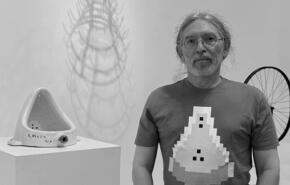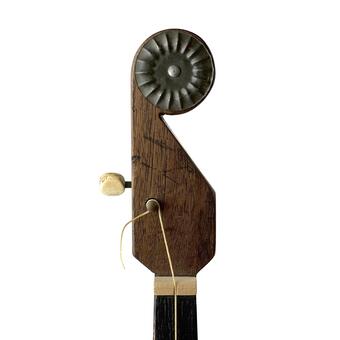About Genna

Genna Gurvich, a conceptual artist living in Baltimore, Maryland. He is a graduate of the Kiev (Ukraine) Institute of Applied Arts and Design and holds a master's degree in System Design from the St. Petersburg Academy of Arts and Industrial Design (Russia).
The primary interest in his practice, Genna Gurvich considers the interconnections and interdependencies in the history of art and culture as a whole. Utilizing computer algorithms, he creates a new visual panorama of these… more
Jump to a project:
Periodic Table of Art Elements: Conceptualism, 2021
Having spent countless hours in my studio and not venturing out much during to the pandemic, I had the time to look toward art history and visual culture as reference points in developing a new project. Titled “The Periodic Table of Art Elements,” my intention was to breakdown and reconstruct an imagining of its various eras, trends, styles and individual artist works as neural networks, the manner by which information is decoded, interconnected, and made interdependent. My goal here was to identify and then fuse the random and disparate visual languages I discovered throughout art history and then remake them in my own visual, pixelated vocabulary. Much like the famed periodic table of chemical elements, my project, using a scientific approach, creates a logical display and expressive presentation of art history’s most iconic works. The result of which, is both alien and familiar as it engages audiences to see
that ubiquitous history from a universal point-of-view.
-
 Joseph BeuysJoseph Beuys was a German artist, teacher, and theorist of art who was highly influential in international contemporary art in the latter half of the 20th century. He is a founder of the art movement known as Fluxus, and a practitioner and exemplar of happenings, and performance art.
Joseph BeuysJoseph Beuys was a German artist, teacher, and theorist of art who was highly influential in international contemporary art in the latter half of the 20th century. He is a founder of the art movement known as Fluxus, and a practitioner and exemplar of happenings, and performance art. -
 Bernhard and Hilla BecherBernhard "Bernd" Becher, and Hilla Becher, were German conceptual artists and photographers working as a collaborative duo. They are best known for their extensive series of photographic images, or typologies, of industrial buildings and structures, often organised in grids.
Bernhard and Hilla BecherBernhard "Bernd" Becher, and Hilla Becher, were German conceptual artists and photographers working as a collaborative duo. They are best known for their extensive series of photographic images, or typologies, of industrial buildings and structures, often organised in grids. -
 Barbara KrugerBarbara Kruger addresses media and politics in their native tongue: sensational, authoritative, and direct. Personal pronouns like “you” and “I” are staples of Kruger’s practice, bringing the viewer into each piece. “Direct address has motored my work from the very beginning,” Kruger said.” She demands that we consider how our identities are formed within culture, through representation in language and image.
Barbara KrugerBarbara Kruger addresses media and politics in their native tongue: sensational, authoritative, and direct. Personal pronouns like “you” and “I” are staples of Kruger’s practice, bringing the viewer into each piece. “Direct address has motored my work from the very beginning,” Kruger said.” She demands that we consider how our identities are formed within culture, through representation in language and image. -
 Chris BurdenChris Burden has produced some of the most shocking works in the history of 20th century American art, including spending five days and nights in the fetal position inside a locker, having a spectator push pins into his body, being "crucified" to a Volkswagen Beetle, being kicked down two flights of stairs, and even having himself shot. The challenge for viewers is to try to understand such troubling and seemingly "inartistic" gestures. Such an understanding is made possible by seeing these works within the context of Conceptual art during the 1970s, where artists concerned themselves with art based on ideas and action rather than objects created for an elite art market.
Chris BurdenChris Burden has produced some of the most shocking works in the history of 20th century American art, including spending five days and nights in the fetal position inside a locker, having a spectator push pins into his body, being "crucified" to a Volkswagen Beetle, being kicked down two flights of stairs, and even having himself shot. The challenge for viewers is to try to understand such troubling and seemingly "inartistic" gestures. Such an understanding is made possible by seeing these works within the context of Conceptual art during the 1970s, where artists concerned themselves with art based on ideas and action rather than objects created for an elite art market. -
 Gordon Matta-ClarkMatta-Clark’s iconic deconstruction practice of directly hacking into hard walls was a sophisticated negotiation of physical boundaries that insisted on the primacy of physical force tied to the artistic imagination.
Gordon Matta-ClarkMatta-Clark’s iconic deconstruction practice of directly hacking into hard walls was a sophisticated negotiation of physical boundaries that insisted on the primacy of physical force tied to the artistic imagination. -
 Erwin WurmErwin Wurm is a contemporary Austrian artist working across several media. Wurm’s comical attitude towards representation features heavily in his Fat Car series, in which he purposefully disfigures car models deemed status symbols by mass culture. Following in the tradition of Joseph Beuys, the artist has contributed his own take on the medium of sculpture with his One Minute Sculptures. In these performances, Wurm invites audience participation and interaction to reevaluate the medium.
Erwin WurmErwin Wurm is a contemporary Austrian artist working across several media. Wurm’s comical attitude towards representation features heavily in his Fat Car series, in which he purposefully disfigures car models deemed status symbols by mass culture. Following in the tradition of Joseph Beuys, the artist has contributed his own take on the medium of sculpture with his One Minute Sculptures. In these performances, Wurm invites audience participation and interaction to reevaluate the medium. -
 Damien HirstDamien Hirst is a British Conceptual artist known for his controversial take on beauty and found-art objects. Death is a central theme in Hirst's works. He became famous for a series of artworks in which dead animals (including a shark, a sheep and a cow) are preserved, sometimes having been dissected, in formaldehyde. The best-known of these was The Physical Impossibility of Death in the Mind of Someone Living, a 14-foot (4.3 m) tiger shark immersed in formaldehyde in a clear display case.
Damien HirstDamien Hirst is a British Conceptual artist known for his controversial take on beauty and found-art objects. Death is a central theme in Hirst's works. He became famous for a series of artworks in which dead animals (including a shark, a sheep and a cow) are preserved, sometimes having been dissected, in formaldehyde. The best-known of these was The Physical Impossibility of Death in the Mind of Someone Living, a 14-foot (4.3 m) tiger shark immersed in formaldehyde in a clear display case. -
 On KawaraOn Kawara was an influential Japanese Conceptual artist. Best known for his Today series of paintings, Kawara produced simple, two-color acrylic paintings to document each day he woke up alive in the date, language, and format of the place in which they were made.
On KawaraOn Kawara was an influential Japanese Conceptual artist. Best known for his Today series of paintings, Kawara produced simple, two-color acrylic paintings to document each day he woke up alive in the date, language, and format of the place in which they were made. -
 John BaldessariJohn Baldessari was an American Conceptual artist known for his pioneering use of appropriated imagery. By blending photography, painting, and text, Baldessari’s work examines the plastic nature of artistic media while offering commentary on our contemporary culture.
John BaldessariJohn Baldessari was an American Conceptual artist known for his pioneering use of appropriated imagery. By blending photography, painting, and text, Baldessari’s work examines the plastic nature of artistic media while offering commentary on our contemporary culture. -
 ChristoChristo, is a conceptual artist who turned to epic-scale environmental works in the late 1960s. His work was typically large, visually impressive, and controversial, often taking years and sometimes decades of careful preparation – including technical solutions, political negotiation, permitting and environmental approval, hearings and public persuasion.
ChristoChristo, is a conceptual artist who turned to epic-scale environmental works in the late 1960s. His work was typically large, visually impressive, and controversial, often taking years and sometimes decades of careful preparation – including technical solutions, political negotiation, permitting and environmental approval, hearings and public persuasion.











